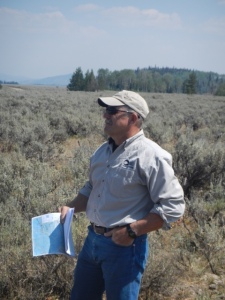
Jake Haefeli with his first mule deer ever. It was taken in the White River area. Photo by Lew Carpenter
Seven prominent groups unite to advocate for backcountry lands
as BLM finalizes management plan administering 1.5 million acres
WASHINGTON – Seven prominent hunting and fishing organizations are speaking out in support of the responsible management of some of the most valuable fish and wildlife habitat in the Rocky Mountain West.
Via advertisements in nine Colorado newspapers, the sportsmen’s groups are urging the Bureau of Land Management to conserve backcountry lands that comprise some of northwest Colorado’s most outstanding public lands hunting and angling. The agency currently is finalizing the White River Resource Management Plan, which will administer 1.5 million acres of federal lands.
The Theodore Roosevelt Conservation Partnership, Backcountry Hunters & Anglers, Bull Moose Sportsmen’s Alliance, Colorado Wildlife Federation, National Wildlife Federation, Trout Unlimited and Western Native Trout Initiative are reaching out together to the BLM.
“Please respect the values of sportsmen by balancing energy development with the protection of our backcountry sporting opportunities and abundant fish and wildlife populations in the White River Resource Management Plan,” the groups state.
The areas in question encompass valuable fish and wildlife habitat. Known as the nation’s “mule deer factory,” northwest Colorado also is home to the largest migratory elk herd in North America and irreplaceable native trout fisheries.
Sporting groups in partnership with local sportsmen and businesses dependent on hunting and angling are requesting that the BLM implement a special land-management classification in an effort to conserve the unique wildlife, recreation, and economic values of the region. Called “backcountry conservation areas,” this management category would conserve specific intact and undeveloped public lands that produce robust game populations and provide high quality hunting and fishing opportunities.
The White River Resource Management Plan Amendment under consideration will guide the BLM’s management of the region’s landscape for the foreseeable future. The White River area offers world-class hunting and angling opportunities as well as abundant mineral resources. An estimated 13,000 wells will be drilled in the area in the next 20 years. Sportsmen are requesting a balanced, conservation-minded approach to this development.
Many sportsmen also support the creation of a master leasing plan in the White River area, which would guide development using a landscape-level management approach.
The sportsmen’s ads will be featured in the Rio Blanco Herald Times on Thursday and in the Denver Post and Craig, Steamboat Springs, Glenwood Springs, Boulder, Loveland, Longmont and Canon City papers on Saturday.
Sportsmen speak directly to the need for responsive backcountry management in northwestern Colorado:
“Sportsmen across the state are depending on the BLM to safeguard our backcountry hunting and fishing grounds and the high quality habitat found on the Western Slope,” said Nick Payne, TRCP Colorado field representative. “To that end, the BLM should implement ‘backcountry conservation areas’ to help maintain the area’s world class public land hunting opportunities.”
“Hunting is a way of life in western Colorado, a tradition that my family has cherished for generations,” said Gabe Lucero, owner of Red Rock Archery in Grand Junction. “As an owner of an archery shop, I also depend on northwest Colorado’s quality hunting to pay the bills year after year. The BLM must ensure that sportsmen still have the opportunity for quality public land hunting indefinitely.”
“The deer, elk and pronghorn herds in northwest Colorado provide hunters a variety of hunting experiences,” said John Ellenberger, a retired wildlife biologist with the Colorado Division of Parks and Wildlife. “Some areas provide the opportunity for a backcountry hunting experience while others provide the opportunity to bag trophy-size animals. In rare instances, some areas supporting these herds provide the opportunity to do both. As both a hunter and a retired wildlife biologist for the Division of Wildlife, I am intimately familiar with these herds and their habitats. I hope the BLM recognizes what needs to be done to preserve these herds for future generations of Coloradoans.”
“Sportsmen understand the need for quality, undeveloped backcountry habitat, just as we understand the need for responsible energy development. There’s no good reason why we can’t have both,” said Tim Brass with the Colorado chapter of Backcountry Hunters & Anglers.
“In northwest Colorado, native cutthroat populations are under pressure, and safeguarding riparian zones and drainages from development is critical for native trout survival and restoration,” said Robin Knox, coordinator for the Western Native Trout Initiative.
“Retreating to the hunting grounds of the Western Slope’s backcountry is a cherished autumn ritual for many of us in Colorado. Conserving these areas is essential to ensuring this tradition will be enjoyed by the next generation,” said Gaspar Perricone, director of the Bull Moose Sportsmen’s Alliance. “Balancing the energy needs of our state with the unique wildlife value of the region is an attainable goal, and the BLM’s resource management plan should reflect the values of each.”
“The White River Basin offers some of the finest sporting opportunities in our country so sportsmen know we need to do our part to ensure that it stays that way,” said Aaron Kindle, Colorado field coordinator for Trout Unlimited’s Sportsmen’s Conservation Project.
“This region epitomizes the image hunters and anglers conjure when dreaming of trophy big game and wild trout, and we encourage the BLM to keep the dream alive for future generations by protecting our access and opportunity,” said John Gale, regional representative for the National Wildlife Federation. “Backcountry conservation areas would help safeguard both.”
Learn more about backcountry conservation areas and how they can sustain fish and wildlife habitat valued by sportsmen.
View the sportsmen’s advertisement here.






